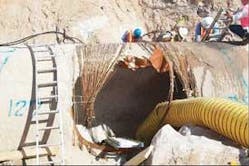• Increasingly incidents seriously affecting public safety and health
by Dr. Jey K. Jeyapalan, P.E.
There are more than eight million miles of pipeline nationwide, with the number of pipeline failures and serious accidents now on the rise.
Multiple Mistakes
Take for example what happened in Boston on the Big-Dig. After years of unstoppable leaks needing continuous pumping of over two million gallons of water each month, a woman was killed on her way to the Logan airport when the roof of the tunnel collapsed. The Boston Globe reported this summer that state and federal officials are now demanding Bechtel-Parsons Brinckerhoff pay as much as $1 billion to settle claims for shoddy work in exchange for a guarantee the consortium won’t face criminal charges, according to the sources with knowledge of the negotiations.
Likewise, in Walnut Creek, CA, in November 2004, a fireball resulted when a backhoe operator hit a jet fuel line next to a trench in which a 72” water pipe was being built for East Bay Municipal Utility District and three welders burned to death.
In another case, a drainage and outfall project with large diameter HDPE became severely over-deflected and failed to meet the state DOT and city’s specifications due to the engineer of record using an inadequate baseline geotechnical investigation and interpretation; specifying a trench design that was meant for reinforced concrete pipe; omitting adequate dewatering specifications; failing to provide clear compaction test specifications, and not providing proper construction oversight. The contractor didn’t adequately dewater the site during pipe installation or follow the city’s specifications. The design engineer also insisted on using reinforced concrete pipe weighing over 1,510 kg/m (1,013 pounds/ft) for the 1,220 mm (48”) outfall even after the geotechnical consultant reported the standard split spoon sampler sank into the poor native soils under its own weight before the 64 kg (140 pound) hammer hit the stem. The unfortunate owner looked into relining the new pipe using cast-in-place pipe even before the remaining portions of the pipeline were completed.
Still More Errors
Those are only a few cases of pipeline failures that could have been avoided. Others include:
• A 84-to-108” welded steel pipe became severely deflected at a $160 million water filtration plant due to improper backfill and bedding selection, improper compaction test specifications, inadequate monitoring of the contractor’s workmanship during construction, and the contractor being permitted to remove the stulls too early. Also, the engineer of record never provided proper guidance to the contractor to prevent loading the crown of the pipe with heavy construction equipment. The contractor was asked by the engineer to excavate the pipe to correct the excessive deflection, thus damaging the steel pipe further. The combination of errors delayed the new treatment plant by more than a year. There was no proper analysis of the geotechnical conditions in this project by the engineer of record.
• When the pre-stressed concrete pipe (PCCP) in a major regional water district began to explode, the desperate owner turned to the pipe supplier and the design engineering firm for help. Both of them attributed the problems to some phenomenon unknown to them in the way the bends were designed, when indeed the independent consultant retained by the utility found the pipe to be deficient in meeting design standards; the design specifications to be deficient; and the bedding and backfilling specifications to be deficient. When the consultant retained by the water utility also found as an additional major cause of the failures that the design engineering firm’s pipe installation specification recommended placement of the bedding by flooding in highly expansive native soils, the design engineering firm lobbied the board of directors of the water utility and brought enormous pressure on the engineering manager of the water utility to switch the failure investigation and all further work to a new consultant who had already worked for the pipe supplier despite a clear conflict of interest. To date, millions of dollars have been spent on better design of the bends, long-term field monitoring to keep counting the pre-stressing wires that are likely to break, and construction of risk curves when indeed the causes of the pipe failure had always been other factors, including gross negligence toward geotechnical data for the pipeline alignment.
• Fiberglass pipe was designed for a sanitary sewer without much consideration of other pipe materials. The soils samples indicated organic material in the foundation for about 10% of the alignment. The design engineer recommended to the owner that steel sheeting be driven for the trench wall and be left in place for the life of the project, increasing the cost of the project from one to five million dollars. The owner who paid design fees for sound engineering decisions had to tell the engineer that this would not be an acceptable design or budget.
• When the primary yard piping for a major water treatment plant was designed with welded steel and PCCP, considerations about corrosion were solely based on the U.S. Department of Agriculture’s Soil Conservation Survey maps. The owner told the engineer of record these maps were outdated, prepared for crop cultivation purposes and never intended for engineering buried pipelines. Due to the engineer of record not having anyone qualified to design the underground pipelines, specified concrete encasement for all of the steel piping. The design engineer didn’t know how to design above-ground piping on supports, so he chose to bury most of the plant piping beneath the footprint of the water treatment facility. There was no consideration about how any repair work on the buried pipe would be performed during the life of the project should an emergency situation ever arise.
Lessons to Be Learned
The above examples are occurrences among engineering firms whose staffs are insufficiently qualified in either geotechnical or pipeline engineering. Yet they’re involved in infrastructure projects, and the assigned project manager may have neither formal training nor sufficient project experience in either geotechnical engineering or pipeline engineering. Often, the pipe vendors, who are good sales people but may lack an adequate engineering background, bring the technical know-how to these complex projects but they may have a conflict of interest and don’t always consider all the technical aspects of the job. Thus, a weak engineer might use the manufacturer’s data, accept poor engineering analysis, and get the owner in trouble. Bad projects that cost the public dearly and don’t provide the promised results can lead to distrust of the civil engineering profession. When a pipeline is designed to be buried, it’s extremely important the design engineers have sufficient experience in both geotechnical and pipeline engineering. Design, construction and management of underground pipelines don’t happen by accident.
More than 40,000 major sewage spills and over 300,000 major water main breaks were reported last year and the public would have reasons to doubt whether a small percentage of these sewage spills and water main breaks are due to aging infrastructure, while the rest are due to unqualified engineers, contractors and inspectors doing pipeline projects. While 100-year-old cast iron and vitrified clay pipe are still working well in some cities like Seattle and Portland due to prudent asset management, much younger pre-stressed concrete cylinder pipe are failing at alarming rates, as shown in Figure 1, resulting in massive floods from water coming out of each such failure, as shown in Figure 2. Adults, children, construction workers and property are affected by these pipeline failures and accidents.
On July 18, an underground steam pipe explosion tore through a Manhattan street near Grand Central Terminal (see Figure 3), swallowing a tow truck and killing one person as hundreds of others ran for cover amid a towering geyser of steam and flying rubble. Mayor Michael Bloomberg said the explosion was not terrorism, though the blast caused a brief panic about a possible attack. Instead, he said of the 24" asbestos-insulated pipe installed in 1924 that there was “no reason to believe whatsoever that this is anything other than a failure of our infrastructure.” The explosion caused widespread chaos as residents and commuters heard a huge blast and feared for the worst. Thousands of commuters evacuated the train terminal, some at a run, after workers yelled for people to get out of the building. A geyser of steam and mud shot from the center of the blast, generating a tremendous roar.
Conclusion
While there’s a dramatic increase in volume of pipeline work, there’s also a severe shortage nationwide of engineers with sufficient experience in underground pipeline design, construction and management. Universities need to offer classes in underground pipelines as part of their curriculum on all forms of transportation. Engineering firms need to be held more accountable by the public and regulatory agencies to prevent them from continuing to take underground pipeline projects and performing shoddy work outside their core competencies. Contractors need to be pre-qualified based on their track record of having completed work of high quality without incident.
About the Author: Dr. Jey K. Jeyapalan, P.E., principal of Dr. Jeyapalan & Associates, of New Milford, CT, is an expert in design, construction and management of underground pipeline projects as a civil engineer, lecturer and author. Based on 30 years of experience as an international engineering consultant, he recently published “Advances in Underground Pipeline Design, Construction and Management.” Dr. Jeyapalan chaired the executive committee of the Pipeline Division of the American Society of Civil Engineers (ASCE) and the ASCE’s 1st and 2nd International Conferences on Advances in Underground Pipeline Engineering. He was the founding chair of ASTM International committee F-36 writing global standards on utilities and underground construction technologies. Contact: 860-354-7299 or [email protected]
Why are pipeline failures and serious accidents on the rise?
- Lack of formal classes and training in underground pipeline design, construction and management in universities around the world.
- Inadequate understanding of pipe-soil interaction principles by design engineers.
- Wide-ranging behavior of pipe materials.
- Claims and counterclaims of pipe manufacturers.
- Inconsistent design standards, sometimes by the same governing body, for different pipe materials.
- Political pressure brought on engineers by pipe interest groups.
- Inappropriate and inadequate utility mapping during design or construction of a pipeline.
- Improper designs and inadequate pipe factory and site supervision by licensed engineers.
- Pipelines being used well beyond their intended design life.
- Improper operation and maintenance.





